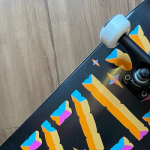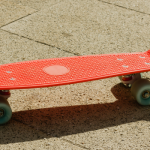Every roll, flip, and grind on the skateboard is a testament to the intricate dance between rider and board. Amidst the focus on decks, trucks, and grip tapes, one element often slips under the radar skateboard wheels. Beyond their role, these circles are the unsung heroes that can make or break a skating experience.
Skateboard wheels, more than just circular appendages, influence performance, maneuverability, and style. They connect rider and terrain, dictating movement, grip, and trick execution. In this exploration, we unravel the significance of skateboard wheels and why they truly matter in skateboarding culture.
Aspects of skateboard wheels:
Skateboard wheels may seem like a simple component, but there are actually several factors that play into their design and performance. Here are some key aspects to consider when looking at skateboard wheels:
Wheel Diameter:
The diameter of skateboard wheels is a fundamental factor that directly influences the ride quality and maneuverability of the skateboard. Wheel diameters typically range from 48mm to 60mm, with variations outside this range catering to specific styles of skateboarding.
Smaller Wheels (48mm – 53mm): Smaller wheels are ideal for street skating and technical tricks. They offer a lower center of gravity, providing more stability for landing tricks and making it easier to perform flip tricks.
Medium-sized Wheels (54mm – 59mm): Medium-sized wheels strike a balance between street and transition skating. They are versatile enough to handle a variety of terrains, making them a popular choice for all-around skateboarders.
Larger Wheels (60mm and above):Larger wheels are suitable for cruising, downhill, and transition skating. They roll over cracks and pebbles more easily, providing a smoother ride. However, they may compromise maneuverability, making them less suitable for technical tricks.
Wheel Hardness (Durometer):
Wheel hardness, measured on the durometer scale, is a critical factor that affects the skateboard’s grip, durability, and overall performance. Durometer ratings typically range from 78A (soft) to 101A (hard).
Soft Wheels (78A – 87A):Soft wheels provide a smoother ride and excellent grip, making them ideal for cruising, commuting, and rough surfaces. They absorb shocks and vibrations, enhancing comfort during long rides.
Medium Wheels (88A – 95A):Medium-hard wheels are versatile and suitable for various styles of skateboarding. They provide a good balance of grip and slide, making them suitable for street, park, and transition skating.
Hard Wheels (96A and above):Hard wheels are preferred by street and technical skaters who prioritize sliding ability. They offer less grip, facilitating controlled slides for tricks like power slides and reverts. However, they may result in a rougher ride on uneven surfaces.
Wheel Shape:
Skateboard wheels come in different shapes, including conical, square-edged, and round-edged. The wheel shape influences how the skateboard responds to turns and slides.
Conical Wheels:Conical wheels have a wider contact patch on one side and a narrower one on the other. This shape enhances control during slides and provides a responsive feel when turning.
Square-edged Wheels:Square-edged wheels offer a larger contact patch, providing more stability. They are often preferred by downhill riders who require maximum traction and control at high speeds.
Round-edged Wheels:Round-edged wheels are versatile and provide a smooth transition from edge to edge. They are suitable for all-around skating, offering a balance of grip and slide.
Wheel Core:
The wheel core, located at the center of the wheel, plays a crucial role in maintaining wheel shape, distributing weight, and impacting overall performance.
Core Placement:Centerset cores offer an equal distribution of weight, providing a consistent feel for both grip and slide. Offset cores are slightly set to one side, enhancing traction and control, making them popular for downhill riding.
Core Material:Cores are made from materials like plastic, fiberglass, or aluminum. A lighter core contributes to faster acceleration, while a heavier core provides more momentum, ideal for downhill and cruising.
Specialized Wheels:
Depending on the rider’s preferences and style, there are specialized wheels designed for specific purposes.
Slide Wheels:Slide wheels are specifically designed for sliding and freestyle tricks. They typically have a harder durometer and a rounded edge for controlled slides.
Cruiser Wheels:Cruiser wheels prioritize a smooth and comfortable ride, with larger diameters and softer durometers. They are ideal for commuting and cruising over various terrains.
Downhill Wheels:Downhill wheels focus on maximum traction and control at high speeds. They often feature larger diameters, harder durometers, and square-edged profiles.
How Wheels Impact Skateboarding Styles?
Different skateboarders have their own unique styles that are reflected in the way they ride, the tricks they do, and even the wheels they use. However, skateboard wheels have a huge impact on the style of skateboarding a person can achieve. Below are some ways in which wheels can influence skateboarding styles:
Trick Versatility:
Skateboard wheels play a pivotal role in determining the versatility of tricks a skater can perform.
Smaller wheels with diameters ranging from 48mm to 53mm are preferred by street skaters for their lower center of gravity, providing stability for technical tricks and flip maneuvers.
These wheels enable riders to master precise footwork and execute intricate street-style tricks.
On the other hand, larger wheels, typically 60mm and above, are favored by transition skaters and downhill enthusiasts for their ability to roll smoothly over obstacles and maintain stability at higher speeds.
Terrain Adaptability:
The type of wheels on a skateboard significantly impacts its adaptability to different terrains.
Softer wheels with lower durometer ratings (78A – 87A) excel on rough surfaces, absorbing shocks and vibrations for a smoother ride.
This makes them ideal for cruising and commuting, where the terrain may be less predictable.
Conversely, harder wheels (96A and above) are better suited for smoother surfaces and provide less traction, making them favorable for technical tricks that involve controlled slides, such as power slides and reverts.
Speed and Momentum:
The size and hardness of skateboard wheels directly affect a skateboard’s speed and momentum.
Larger wheels have a greater circumference, covering more ground per revolution and resulting in higher speeds. This makes them well-suited for downhill riding and long-distance cruising.
On the contrary, smaller wheels offer quicker acceleration and are favored by street skaters who need to execute rapid tricks and maneuvers in a confined space.
The weight and material of the wheel’s core contribute to maintaining momentum, influencing how the skateboard responds to pushes and transitions.
Grip and Control:
The durometer or hardness of skateboard wheels is a key factor influencing grip and control. Softer wheels provide more grip, enhancing stability during turns and tricks.
This is crucial for riders who prioritize control, such as those navigating ramps and bowls. On the other hand, harder wheels offer less grip, facilitating controlled slides.
Skaters who specialize in technical street tricks often prefer the reduced friction of harder wheels, allowing for precise slides and spins without sacrificing overall control.
Specialized Disciplines:
Skateboard wheels are often tailored to specific disciplines within the sport.
For example, slide wheels are designed with a harder durometer and a rounded edge to facilitate controlled slides, making them ideal for freestyle and sliding tricks.
Cruiser wheels, characterized by larger diameters and softer durometers, prioritize comfort and smooth rides over various terrains, catering to the needs of skateboarders who use their boards for transportation.
Downhill wheels, with their larger diameters, harder durometers, and square-edged profiles, provide maximum traction and control at high speeds, addressing the unique demands of downhill riders.
Conclusion:
As you see, skateboard wheels are a crucial component that significantly influences the overall performance and experience of riding a skateboard.
Whether you’re a street skater, a park enthusiast, or someone who enjoys cruising down hills, choosing the right wheels can make a substantial difference in your skateboarding journey.
Understanding the nuances of wheel diameter, hardness, shape, core, and specialized options empowers skateboarders to tailor their setups to their individual preferences and styles, ultimately enhancing their ability to push the boundaries of creativity and skill on four small wheels.
So, the next time you step into a skateboard shop, remember that the seemingly humble wheels are, in fact, a key determinant of your ride’s smoothness, grip, and overall performance.
![Why do skateboarders hate scooters? [Reasons + Tips] Why do skateboarders hate scooters? [Reasons + Tips]](https://bedoper.site/wp-content/uploads/2023/04/Why-do-skateboarders-hate-scooters-150x150.png)


![How fast do skateboards go downhill? [90 mph (145 km/h)] How fast do skateboards go downhill? [90 mph (145 km/h)]](https://bedoper.site/wp-content/uploads/2023/04/How-fast-do-skateboards-go-downhill-150x150.png)
